| back to
Wildflowers of North
Carolina |
|
| The NCNatural Guide to Plants and Flowers of the NC Coast Barrier Islands |
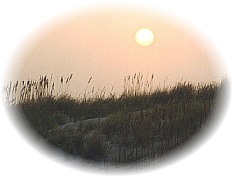 |
| back to
Wildflowers of North
Carolina |
|
| The NCNatural Guide to Plants and Flowers of the NC Coast Barrier Islands |
 |
Not many plant species can tolerate the harsh growing conditions of North Carolina's barrier islands, especially in the beach zone. The salt blown in from the ocean keeps many plants completely at bay (so to speak). Many of the rugged individuals that can stand the environment are native to the southeast US region, with some at the northern limits of their range here.
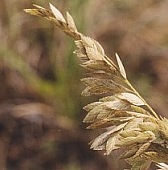 |
Sea Oats (Uniola Paniculata) Perennial grass. 3' - 4' or more tall. Sandy dune area to the max high-tide line. Range from Virginia coastward to Texas. |
Sea Oats are easily recognized due to their tall size and conspicuous slender shape, growing especially near the beach. This is a plant that readily tolerates both salt spray and occasionally salt water. Root balls and old leaves form clumps of organic matter that trap sand and make these plants very useful in holding the beach together. These are among the first colonizing plants of the sand and are used extensively to prevent beach erosion. |
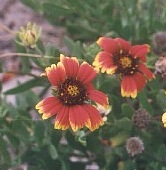 |
Gaillardia aka Fire-Wheel, Indian Blanket (Gaillardia pulchella) Self-seeding annuals, 6" - 24" tall. Growing in sand along roadsides and behind dunes. Blooming April to October. |
These are easily seen flowers of the barrier islands. You're very likely to see them on the walk to the beach as they grow in the soft sand. They are very prolific but they are escapes from cultivation, though at the northern limit of their range. They are now thoroughly naturalized from North Carolina to Florida. |
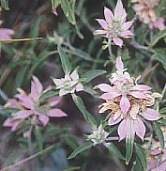 |
Dotted Horsemint
(Monarda punctata) Perennial member of the mint family. 6" to 3'. Sandy or dry soils of the coast and piedmont, north to Long Island and throughout the south to Texas. Blooms late July to October. |
Dotted Horsemint is another plant of the dune area. It is relatively common throughout the coastal plain and tapering off into the piedmont. Horsemint has been used medicinally by Native Americans as well as doctors in more recent times. Oil from the plant is high in Thymol, an antiseptic and local anesthetic used in liniments, lip balms, toothpaste, mouthwash. Thymol is produced synthetically these days but used to be derived from the Thyme plant. During World War I the European commercial Thyme fields were destroyed and Dotted Horsemint from the US replaced Thyme as a source for Thymol. |
 |
Hypericum (Hypericum sp.) Small herbaceous shrub, 5" - 20" tall. Grow in dunes, sandy woods and scrub from North Carolina south to Florida and to Alabama. Blooms June to September. |
The Hypericums are also known as St. John's Wort, which is very popular these days for self-treating depression and anxiety. This species is probably Hypericum reductum, though plants of this group intergrade readily and it is somewhat difficult to determine. This is not one of the species usually used medicinally. |
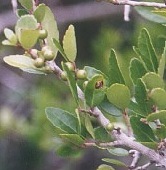 |
Yaupon (Ilex vomitoria) Evergreen shrub or small tree of the Holly family, 6' - 15' tall. Leaves 2", elliptical, leathery and round-toothed. Range Sandy woods from Virginia coastward to Texas. Produces berries which turn red in the fall. |
The Yaupon is one of the most common shrubs of the barrier islands and salt marshes of the coastal plain. It is also found in sandy woods into the piedmont, including occasionally in the sandhills area. There are many stories of Native Americans and their "Black Drink" that was used ceremonially as a purgative purifying agent. The Black Drink is derived from the Yaupon though it is not recommended that you injest holly berries as many hollys are considered toxic. |
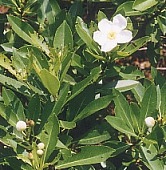 |
Loblolly Bay (Gordonia lasianthus) Evergreen shrub or small tree of the maritime forest, pocosins and low woods of the coastal plain. 2" white flowers bloom July to August. Range from NC coastward to Mississippi. |
This plant is so well-entrenched in our range that it gives its name to a particular kind of natural community. In many parts of the world, the term "bay" signifies a body of water at least partly protected by land, but in North Carolina a bay is low, wet forest that is dominated by the Loblolly Bay tree which forms dense thickets and is very hard to get through. (We generally call our bodies of water that are protected by land "Sounds".) The Loblolly Bay is at the northern limit of its range in NC. It is a predominant plant of the maritime forest and occurs at many sites inland on the coastal plain. |
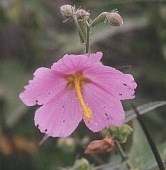 |
Swamp Mallow aka Marshmallow, Swamp Rose (Hibiscus mosheutus) 5' - 7' tall perennial found in the salt and brackish marsh environments from Maryland southward through much of the southeast. Flowers up to 4" - 8" across, usually white with reddish/purple center, blooming June to September. |
The Swamp Mallow is a conspicuous marsh flower that is easily spotted due to its size. Its appearance seems like it is out of place in the marsh and probably escaped from someone's garden, but this is not the case. The juice from the leaves and roots of this plant, and the mallow family in general, can be used as an emollient to soften and soothe skin. |
 |
Yellow Jessamine (Gelsemium sempervirens) Trailing or climbing woody vines with wiry stems found throughout the coastal plain of the southeast. Many 1" yellow flowers make this a conspicuous plant of the early spring. Blooms March-April. |
In thickets, woodlands and
along roadsides throughout the southeast, the viney Yellow Jessamine brings
bright color to the early spring landscape. It is the state flower of South
Carolina. Despite its attractive appearance, the plant is considered a deadly poison and should not be injested. Even touching it can cause contact dermatitis. |
 |
 |
 |
 |
© 1999 NCNatural
Last updated
For information about advertising or webservices, email "[email protected]"
all images copyright 1994-1999 Tim
Treadwell